Digital Forensics: Current and Future IoT Challenges Analysis
VerifiedAdded on 2022/09/09
|12
|2878
|17
Report
AI Summary
This report delves into the realm of digital forensics, specifically addressing the current and future challenges presented by the Internet of Things (IoT). It begins by defining digital forensics and its importance in data recovery and investigation, highlighting the role of IoT devices in providing new sources of digital evidence. The report then outlines the technical, legal, and resource-related challenges faced in digital forensics, such as data volume, complexity, anti-forensic techniques, privacy issues, and encryption deficiencies. It explores the benefits of integrating IoT in digital forensics, enabling better data management and insights into cybercrime. However, the report also examines the challenges associated with IoT devices, including data location, the lifespan of digital media, security concerns, and data format inconsistencies. Finally, it proposes solutions, such as efficient data management, encryption methods, and adherence to proper procedures to overcome these issues and protect digital evidence. The report concludes by emphasizing the importance of digital forensics in combating cybercrimes and the need for continuous technological advancements to enhance its effectiveness.
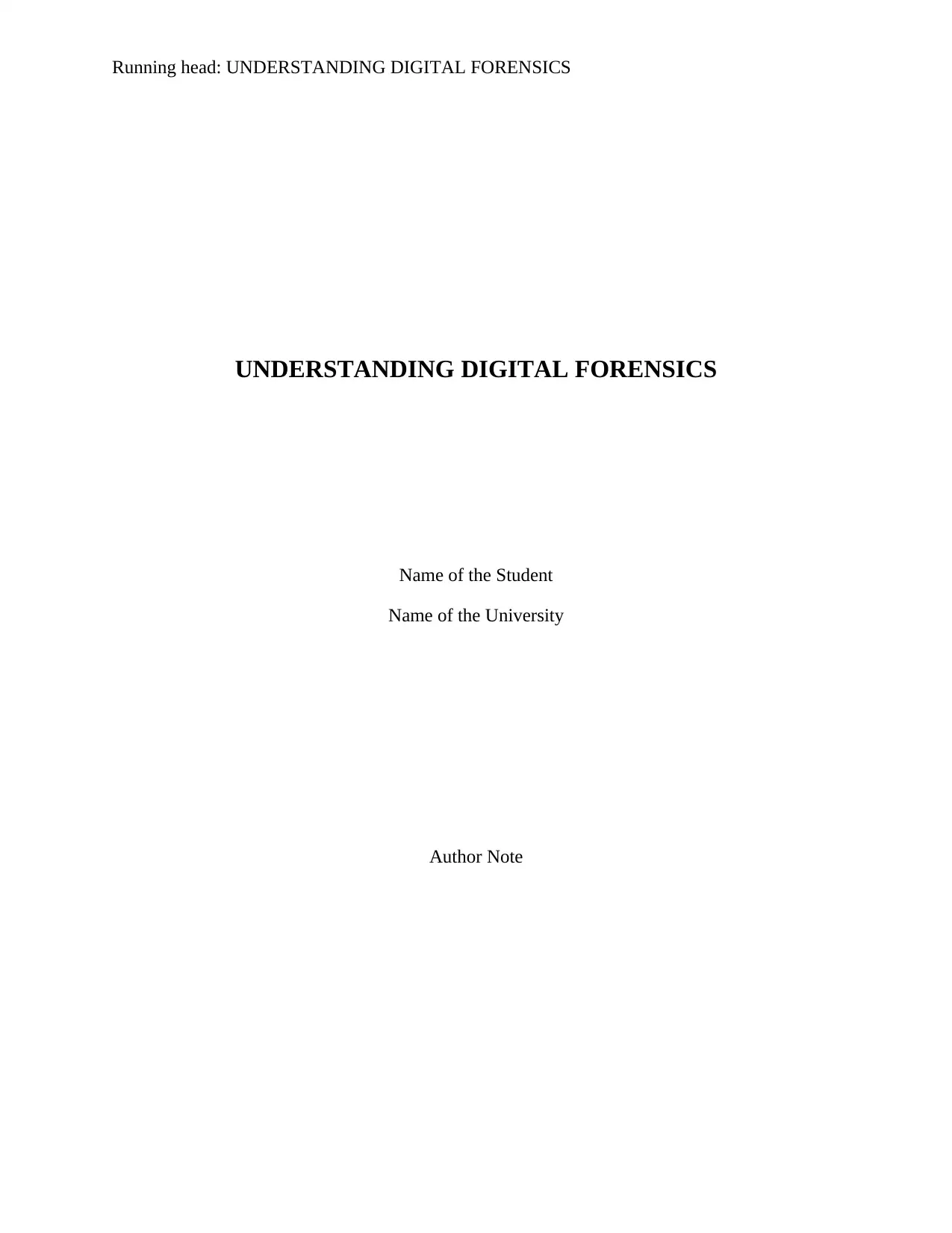
Running head: UNDERSTANDING DIGITAL FORENSICS
UNDERSTANDING DIGITAL FORENSICS
Name of the Student
Name of the University
Author Note
UNDERSTANDING DIGITAL FORENSICS
Name of the Student
Name of the University
Author Note
Paraphrase This Document
Need a fresh take? Get an instant paraphrase of this document with our AI Paraphraser
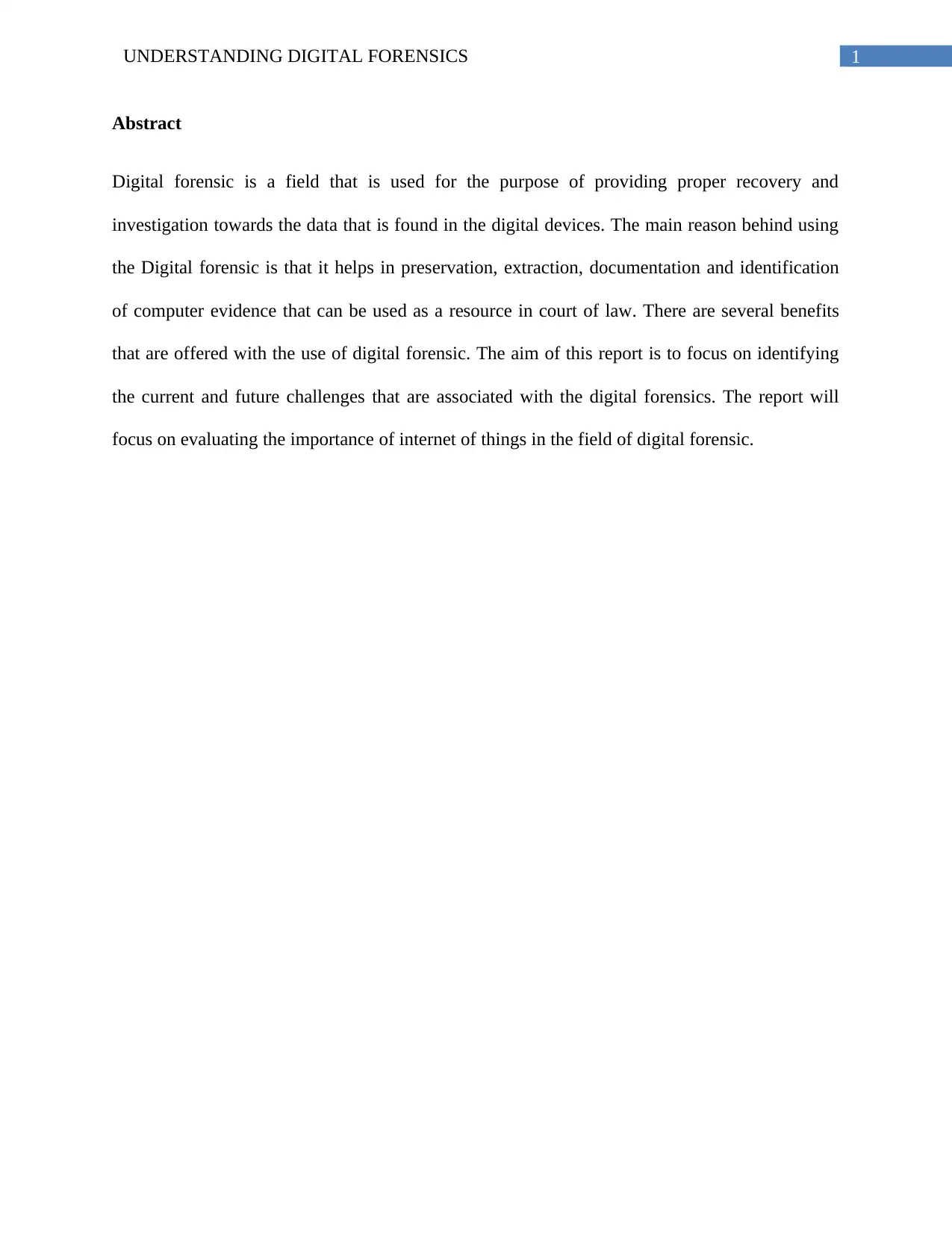
1UNDERSTANDING DIGITAL FORENSICS
Abstract
Digital forensic is a field that is used for the purpose of providing proper recovery and
investigation towards the data that is found in the digital devices. The main reason behind using
the Digital forensic is that it helps in preservation, extraction, documentation and identification
of computer evidence that can be used as a resource in court of law. There are several benefits
that are offered with the use of digital forensic. The aim of this report is to focus on identifying
the current and future challenges that are associated with the digital forensics. The report will
focus on evaluating the importance of internet of things in the field of digital forensic.
Abstract
Digital forensic is a field that is used for the purpose of providing proper recovery and
investigation towards the data that is found in the digital devices. The main reason behind using
the Digital forensic is that it helps in preservation, extraction, documentation and identification
of computer evidence that can be used as a resource in court of law. There are several benefits
that are offered with the use of digital forensic. The aim of this report is to focus on identifying
the current and future challenges that are associated with the digital forensics. The report will
focus on evaluating the importance of internet of things in the field of digital forensic.
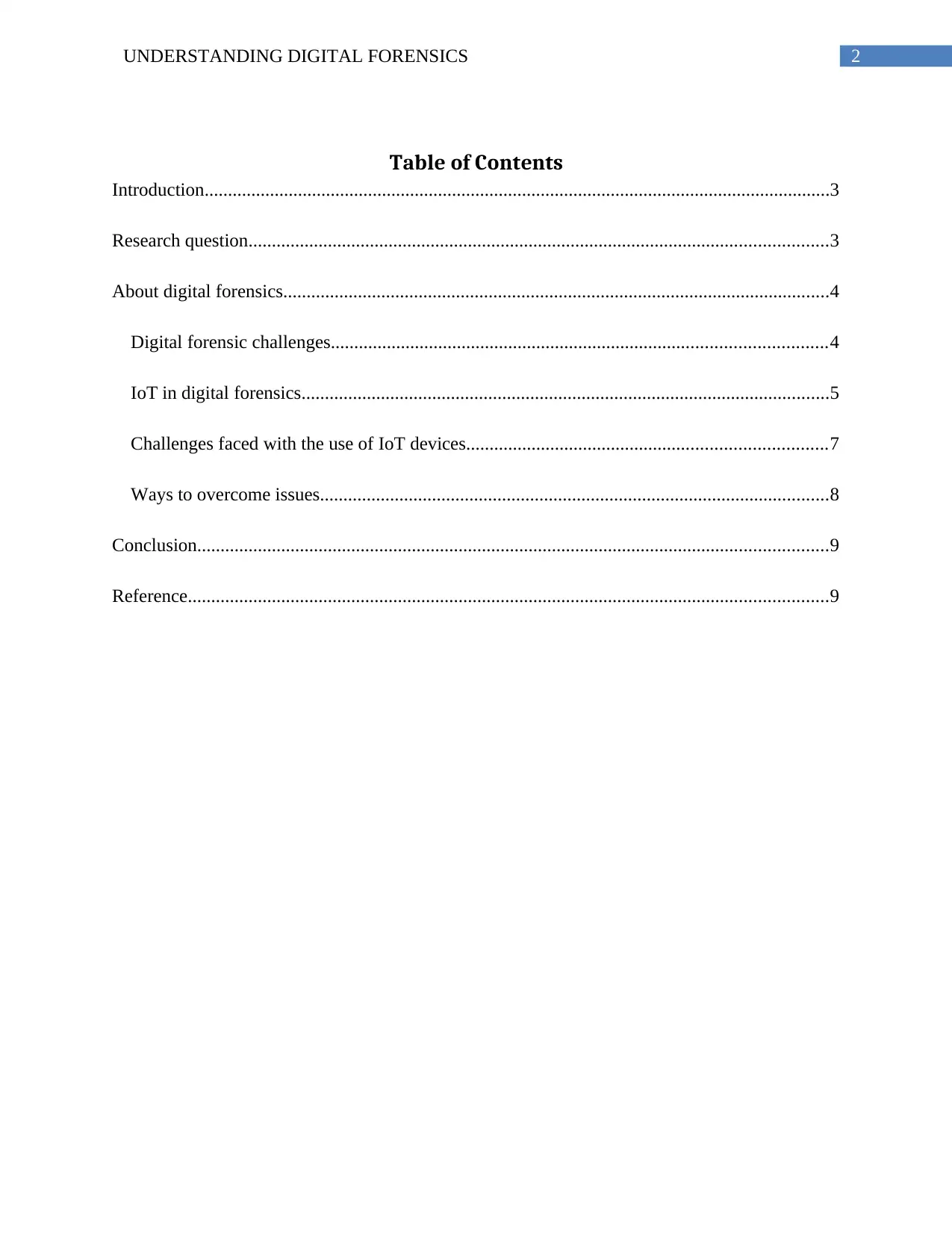
2UNDERSTANDING DIGITAL FORENSICS
Table of Contents
Introduction......................................................................................................................................3
Research question............................................................................................................................3
About digital forensics.....................................................................................................................4
Digital forensic challenges..........................................................................................................4
IoT in digital forensics.................................................................................................................5
Challenges faced with the use of IoT devices.............................................................................7
Ways to overcome issues.............................................................................................................8
Conclusion.......................................................................................................................................9
Reference.........................................................................................................................................9
Table of Contents
Introduction......................................................................................................................................3
Research question............................................................................................................................3
About digital forensics.....................................................................................................................4
Digital forensic challenges..........................................................................................................4
IoT in digital forensics.................................................................................................................5
Challenges faced with the use of IoT devices.............................................................................7
Ways to overcome issues.............................................................................................................8
Conclusion.......................................................................................................................................9
Reference.........................................................................................................................................9
⊘ This is a preview!⊘
Do you want full access?
Subscribe today to unlock all pages.

Trusted by 1+ million students worldwide
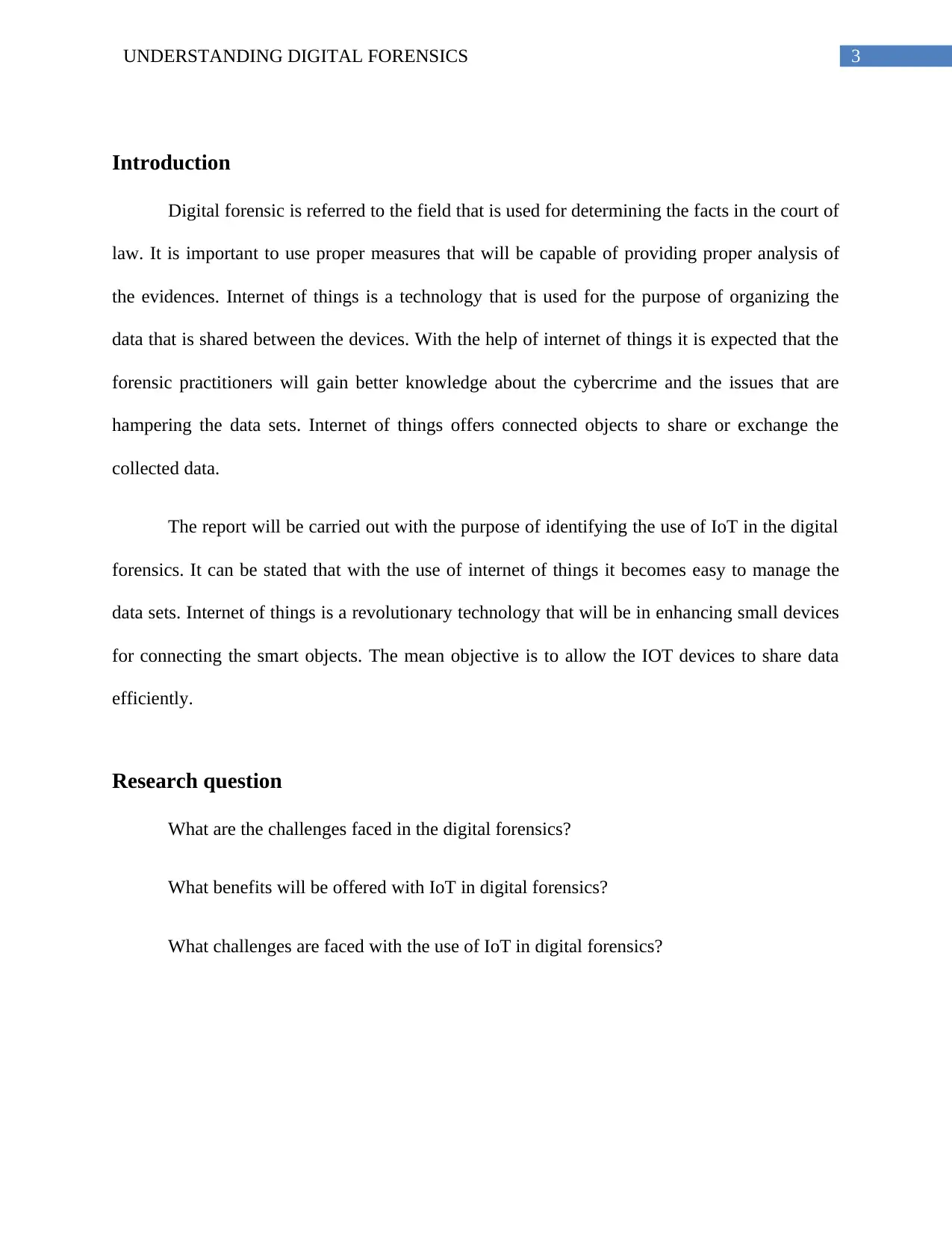
3UNDERSTANDING DIGITAL FORENSICS
Introduction
Digital forensic is referred to the field that is used for determining the facts in the court of
law. It is important to use proper measures that will be capable of providing proper analysis of
the evidences. Internet of things is a technology that is used for the purpose of organizing the
data that is shared between the devices. With the help of internet of things it is expected that the
forensic practitioners will gain better knowledge about the cybercrime and the issues that are
hampering the data sets. Internet of things offers connected objects to share or exchange the
collected data.
The report will be carried out with the purpose of identifying the use of IoT in the digital
forensics. It can be stated that with the use of internet of things it becomes easy to manage the
data sets. Internet of things is a revolutionary technology that will be in enhancing small devices
for connecting the smart objects. The mean objective is to allow the IOT devices to share data
efficiently.
Research question
What are the challenges faced in the digital forensics?
What benefits will be offered with IoT in digital forensics?
What challenges are faced with the use of IoT in digital forensics?
Introduction
Digital forensic is referred to the field that is used for determining the facts in the court of
law. It is important to use proper measures that will be capable of providing proper analysis of
the evidences. Internet of things is a technology that is used for the purpose of organizing the
data that is shared between the devices. With the help of internet of things it is expected that the
forensic practitioners will gain better knowledge about the cybercrime and the issues that are
hampering the data sets. Internet of things offers connected objects to share or exchange the
collected data.
The report will be carried out with the purpose of identifying the use of IoT in the digital
forensics. It can be stated that with the use of internet of things it becomes easy to manage the
data sets. Internet of things is a revolutionary technology that will be in enhancing small devices
for connecting the smart objects. The mean objective is to allow the IOT devices to share data
efficiently.
Research question
What are the challenges faced in the digital forensics?
What benefits will be offered with IoT in digital forensics?
What challenges are faced with the use of IoT in digital forensics?
Paraphrase This Document
Need a fresh take? Get an instant paraphrase of this document with our AI Paraphraser
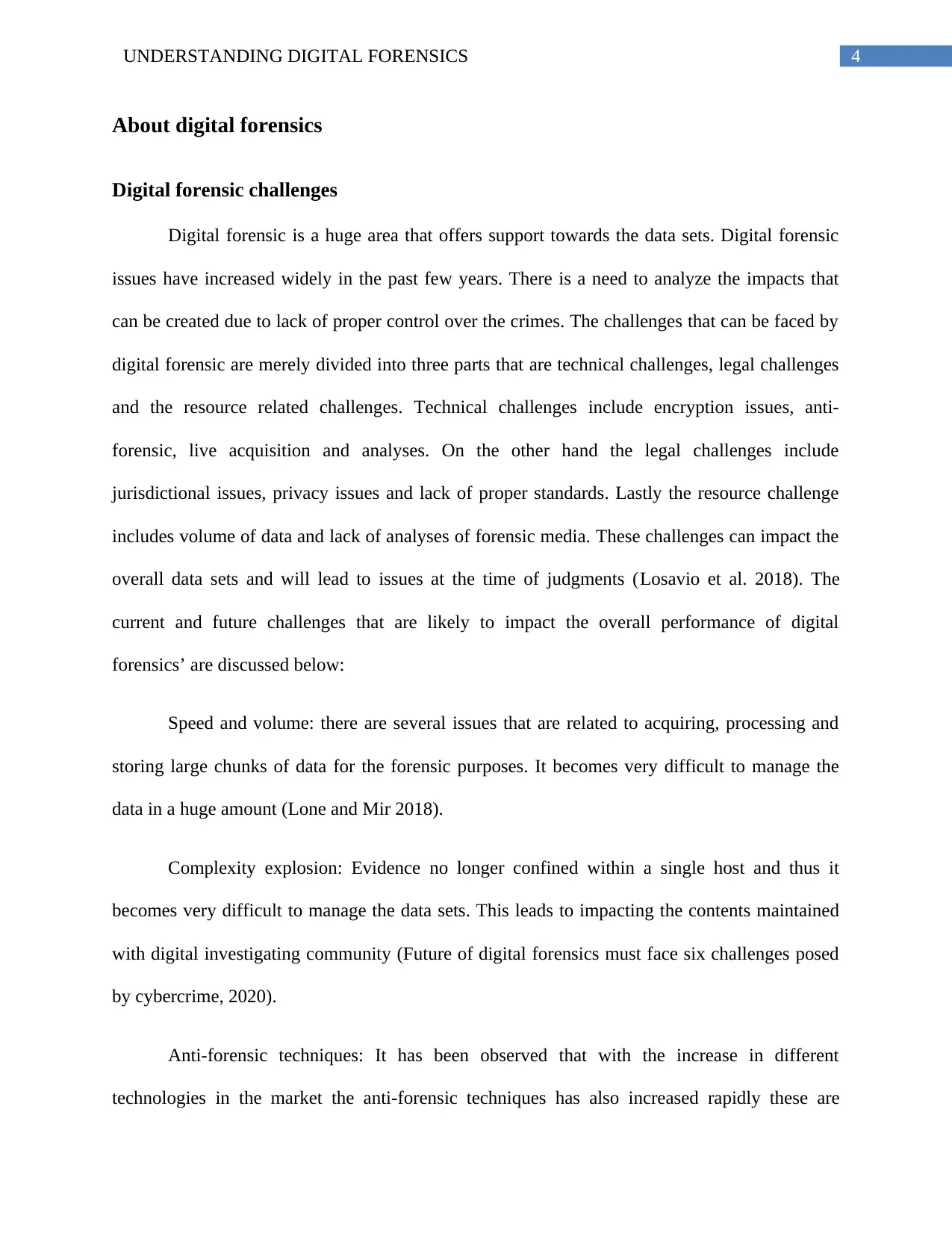
4UNDERSTANDING DIGITAL FORENSICS
About digital forensics
Digital forensic challenges
Digital forensic is a huge area that offers support towards the data sets. Digital forensic
issues have increased widely in the past few years. There is a need to analyze the impacts that
can be created due to lack of proper control over the crimes. The challenges that can be faced by
digital forensic are merely divided into three parts that are technical challenges, legal challenges
and the resource related challenges. Technical challenges include encryption issues, anti-
forensic, live acquisition and analyses. On the other hand the legal challenges include
jurisdictional issues, privacy issues and lack of proper standards. Lastly the resource challenge
includes volume of data and lack of analyses of forensic media. These challenges can impact the
overall data sets and will lead to issues at the time of judgments (Losavio et al. 2018). The
current and future challenges that are likely to impact the overall performance of digital
forensics’ are discussed below:
Speed and volume: there are several issues that are related to acquiring, processing and
storing large chunks of data for the forensic purposes. It becomes very difficult to manage the
data in a huge amount (Lone and Mir 2018).
Complexity explosion: Evidence no longer confined within a single host and thus it
becomes very difficult to manage the data sets. This leads to impacting the contents maintained
with digital investigating community (Future of digital forensics must face six challenges posed
by cybercrime, 2020).
Anti-forensic techniques: It has been observed that with the increase in different
technologies in the market the anti-forensic techniques has also increased rapidly these are
About digital forensics
Digital forensic challenges
Digital forensic is a huge area that offers support towards the data sets. Digital forensic
issues have increased widely in the past few years. There is a need to analyze the impacts that
can be created due to lack of proper control over the crimes. The challenges that can be faced by
digital forensic are merely divided into three parts that are technical challenges, legal challenges
and the resource related challenges. Technical challenges include encryption issues, anti-
forensic, live acquisition and analyses. On the other hand the legal challenges include
jurisdictional issues, privacy issues and lack of proper standards. Lastly the resource challenge
includes volume of data and lack of analyses of forensic media. These challenges can impact the
overall data sets and will lead to issues at the time of judgments (Losavio et al. 2018). The
current and future challenges that are likely to impact the overall performance of digital
forensics’ are discussed below:
Speed and volume: there are several issues that are related to acquiring, processing and
storing large chunks of data for the forensic purposes. It becomes very difficult to manage the
data in a huge amount (Lone and Mir 2018).
Complexity explosion: Evidence no longer confined within a single host and thus it
becomes very difficult to manage the data sets. This leads to impacting the contents maintained
with digital investigating community (Future of digital forensics must face six challenges posed
by cybercrime, 2020).
Anti-forensic techniques: It has been observed that with the increase in different
technologies in the market the anti-forensic techniques has also increased rapidly these are
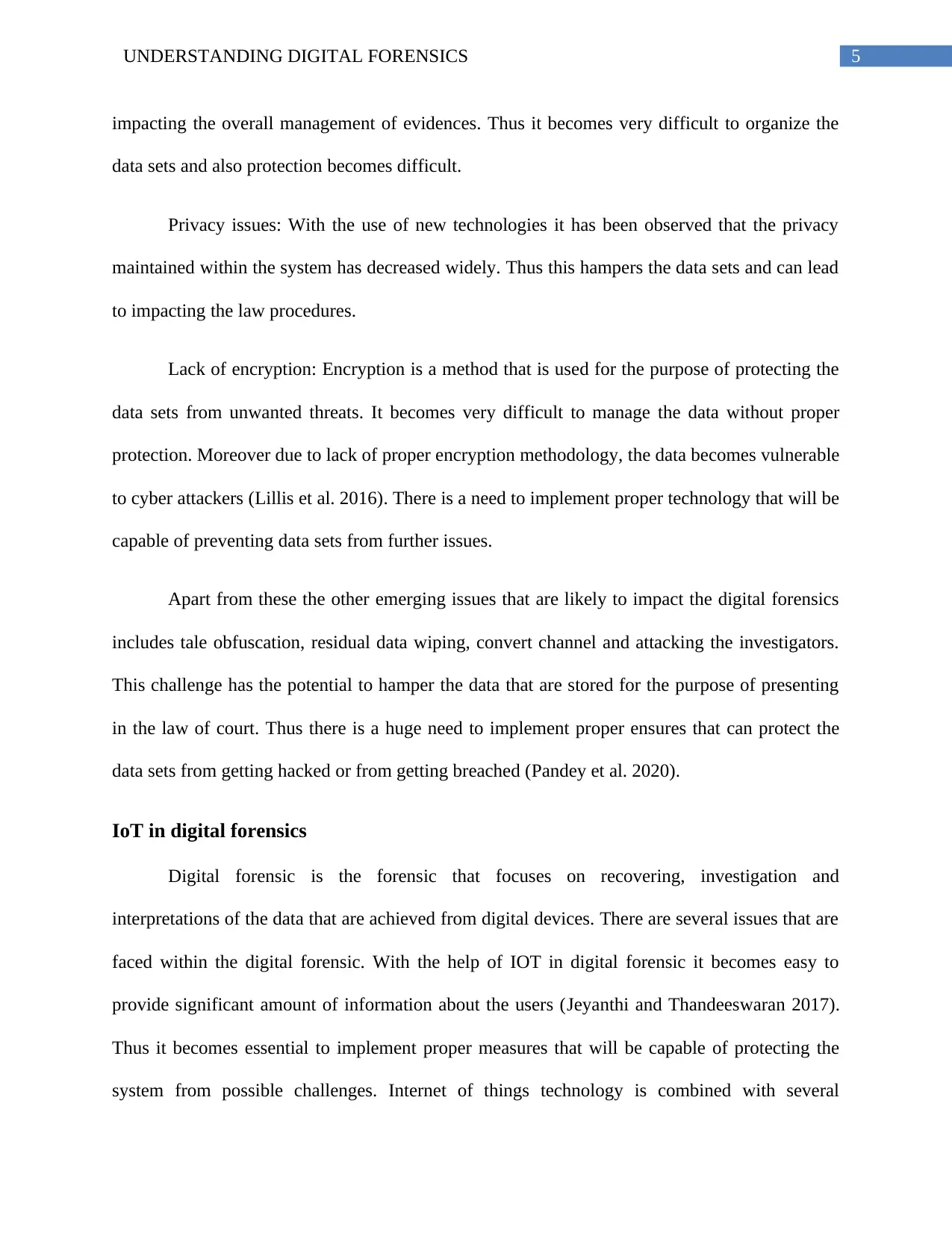
5UNDERSTANDING DIGITAL FORENSICS
impacting the overall management of evidences. Thus it becomes very difficult to organize the
data sets and also protection becomes difficult.
Privacy issues: With the use of new technologies it has been observed that the privacy
maintained within the system has decreased widely. Thus this hampers the data sets and can lead
to impacting the law procedures.
Lack of encryption: Encryption is a method that is used for the purpose of protecting the
data sets from unwanted threats. It becomes very difficult to manage the data without proper
protection. Moreover due to lack of proper encryption methodology, the data becomes vulnerable
to cyber attackers (Lillis et al. 2016). There is a need to implement proper technology that will be
capable of preventing data sets from further issues.
Apart from these the other emerging issues that are likely to impact the digital forensics
includes tale obfuscation, residual data wiping, convert channel and attacking the investigators.
This challenge has the potential to hamper the data that are stored for the purpose of presenting
in the law of court. Thus there is a huge need to implement proper ensures that can protect the
data sets from getting hacked or from getting breached (Pandey et al. 2020).
IoT in digital forensics
Digital forensic is the forensic that focuses on recovering, investigation and
interpretations of the data that are achieved from digital devices. There are several issues that are
faced within the digital forensic. With the help of IOT in digital forensic it becomes easy to
provide significant amount of information about the users (Jeyanthi and Thandeeswaran 2017).
Thus it becomes essential to implement proper measures that will be capable of protecting the
system from possible challenges. Internet of things technology is combined with several
impacting the overall management of evidences. Thus it becomes very difficult to organize the
data sets and also protection becomes difficult.
Privacy issues: With the use of new technologies it has been observed that the privacy
maintained within the system has decreased widely. Thus this hampers the data sets and can lead
to impacting the law procedures.
Lack of encryption: Encryption is a method that is used for the purpose of protecting the
data sets from unwanted threats. It becomes very difficult to manage the data without proper
protection. Moreover due to lack of proper encryption methodology, the data becomes vulnerable
to cyber attackers (Lillis et al. 2016). There is a need to implement proper technology that will be
capable of preventing data sets from further issues.
Apart from these the other emerging issues that are likely to impact the digital forensics
includes tale obfuscation, residual data wiping, convert channel and attacking the investigators.
This challenge has the potential to hamper the data that are stored for the purpose of presenting
in the law of court. Thus there is a huge need to implement proper ensures that can protect the
data sets from getting hacked or from getting breached (Pandey et al. 2020).
IoT in digital forensics
Digital forensic is the forensic that focuses on recovering, investigation and
interpretations of the data that are achieved from digital devices. There are several issues that are
faced within the digital forensic. With the help of IOT in digital forensic it becomes easy to
provide significant amount of information about the users (Jeyanthi and Thandeeswaran 2017).
Thus it becomes essential to implement proper measures that will be capable of protecting the
system from possible challenges. Internet of things technology is combined with several
⊘ This is a preview!⊘
Do you want full access?
Subscribe today to unlock all pages.

Trusted by 1+ million students worldwide
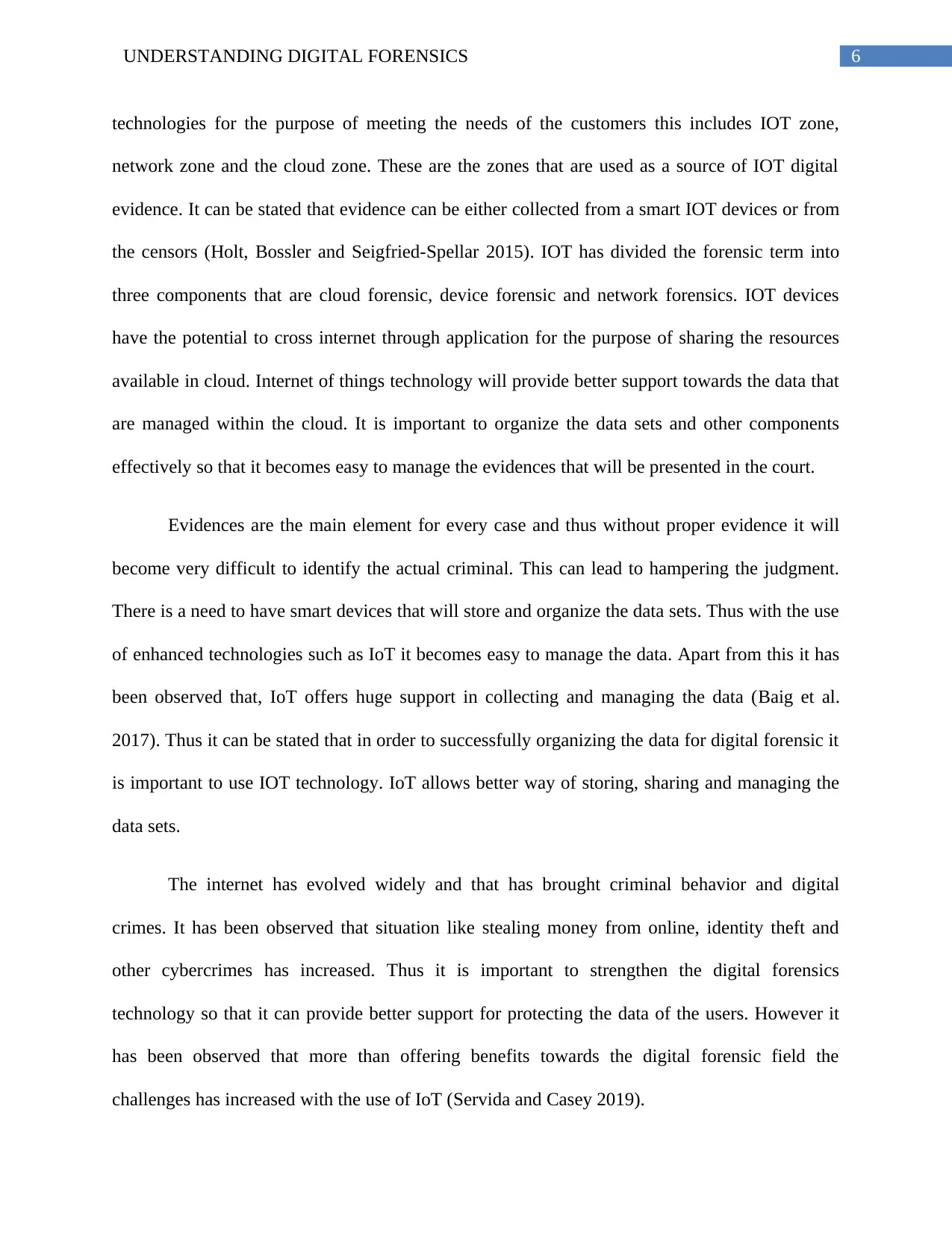
6UNDERSTANDING DIGITAL FORENSICS
technologies for the purpose of meeting the needs of the customers this includes IOT zone,
network zone and the cloud zone. These are the zones that are used as a source of IOT digital
evidence. It can be stated that evidence can be either collected from a smart IOT devices or from
the censors (Holt, Bossler and Seigfried-Spellar 2015). IOT has divided the forensic term into
three components that are cloud forensic, device forensic and network forensics. IOT devices
have the potential to cross internet through application for the purpose of sharing the resources
available in cloud. Internet of things technology will provide better support towards the data that
are managed within the cloud. It is important to organize the data sets and other components
effectively so that it becomes easy to manage the evidences that will be presented in the court.
Evidences are the main element for every case and thus without proper evidence it will
become very difficult to identify the actual criminal. This can lead to hampering the judgment.
There is a need to have smart devices that will store and organize the data sets. Thus with the use
of enhanced technologies such as IoT it becomes easy to manage the data. Apart from this it has
been observed that, IoT offers huge support in collecting and managing the data (Baig et al.
2017). Thus it can be stated that in order to successfully organizing the data for digital forensic it
is important to use IOT technology. IoT allows better way of storing, sharing and managing the
data sets.
The internet has evolved widely and that has brought criminal behavior and digital
crimes. It has been observed that situation like stealing money from online, identity theft and
other cybercrimes has increased. Thus it is important to strengthen the digital forensics
technology so that it can provide better support for protecting the data of the users. However it
has been observed that more than offering benefits towards the digital forensic field the
challenges has increased with the use of IoT (Servida and Casey 2019).
technologies for the purpose of meeting the needs of the customers this includes IOT zone,
network zone and the cloud zone. These are the zones that are used as a source of IOT digital
evidence. It can be stated that evidence can be either collected from a smart IOT devices or from
the censors (Holt, Bossler and Seigfried-Spellar 2015). IOT has divided the forensic term into
three components that are cloud forensic, device forensic and network forensics. IOT devices
have the potential to cross internet through application for the purpose of sharing the resources
available in cloud. Internet of things technology will provide better support towards the data that
are managed within the cloud. It is important to organize the data sets and other components
effectively so that it becomes easy to manage the evidences that will be presented in the court.
Evidences are the main element for every case and thus without proper evidence it will
become very difficult to identify the actual criminal. This can lead to hampering the judgment.
There is a need to have smart devices that will store and organize the data sets. Thus with the use
of enhanced technologies such as IoT it becomes easy to manage the data. Apart from this it has
been observed that, IoT offers huge support in collecting and managing the data (Baig et al.
2017). Thus it can be stated that in order to successfully organizing the data for digital forensic it
is important to use IOT technology. IoT allows better way of storing, sharing and managing the
data sets.
The internet has evolved widely and that has brought criminal behavior and digital
crimes. It has been observed that situation like stealing money from online, identity theft and
other cybercrimes has increased. Thus it is important to strengthen the digital forensics
technology so that it can provide better support for protecting the data of the users. However it
has been observed that more than offering benefits towards the digital forensic field the
challenges has increased with the use of IoT (Servida and Casey 2019).
Paraphrase This Document
Need a fresh take? Get an instant paraphrase of this document with our AI Paraphraser
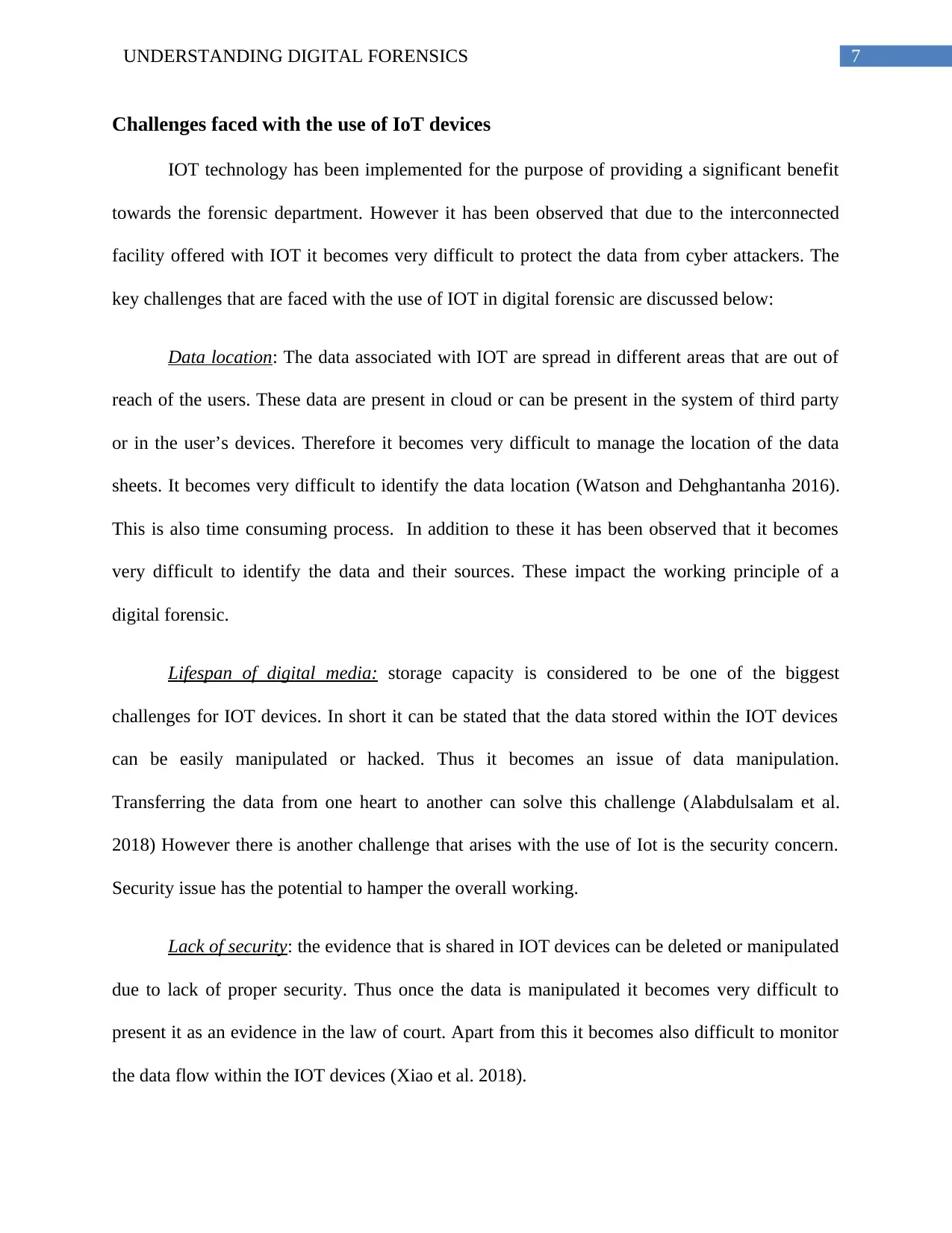
7UNDERSTANDING DIGITAL FORENSICS
Challenges faced with the use of IoT devices
IOT technology has been implemented for the purpose of providing a significant benefit
towards the forensic department. However it has been observed that due to the interconnected
facility offered with IOT it becomes very difficult to protect the data from cyber attackers. The
key challenges that are faced with the use of IOT in digital forensic are discussed below:
Data location: The data associated with IOT are spread in different areas that are out of
reach of the users. These data are present in cloud or can be present in the system of third party
or in the user’s devices. Therefore it becomes very difficult to manage the location of the data
sheets. It becomes very difficult to identify the data location (Watson and Dehghantanha 2016).
This is also time consuming process. In addition to these it has been observed that it becomes
very difficult to identify the data and their sources. These impact the working principle of a
digital forensic.
Lifespan of digital media: storage capacity is considered to be one of the biggest
challenges for IOT devices. In short it can be stated that the data stored within the IOT devices
can be easily manipulated or hacked. Thus it becomes an issue of data manipulation.
Transferring the data from one heart to another can solve this challenge (Alabdulsalam et al.
2018) However there is another challenge that arises with the use of Iot is the security concern.
Security issue has the potential to hamper the overall working.
Lack of security: the evidence that is shared in IOT devices can be deleted or manipulated
due to lack of proper security. Thus once the data is manipulated it becomes very difficult to
present it as an evidence in the law of court. Apart from this it becomes also difficult to monitor
the data flow within the IOT devices (Xiao et al. 2018).
Challenges faced with the use of IoT devices
IOT technology has been implemented for the purpose of providing a significant benefit
towards the forensic department. However it has been observed that due to the interconnected
facility offered with IOT it becomes very difficult to protect the data from cyber attackers. The
key challenges that are faced with the use of IOT in digital forensic are discussed below:
Data location: The data associated with IOT are spread in different areas that are out of
reach of the users. These data are present in cloud or can be present in the system of third party
or in the user’s devices. Therefore it becomes very difficult to manage the location of the data
sheets. It becomes very difficult to identify the data location (Watson and Dehghantanha 2016).
This is also time consuming process. In addition to these it has been observed that it becomes
very difficult to identify the data and their sources. These impact the working principle of a
digital forensic.
Lifespan of digital media: storage capacity is considered to be one of the biggest
challenges for IOT devices. In short it can be stated that the data stored within the IOT devices
can be easily manipulated or hacked. Thus it becomes an issue of data manipulation.
Transferring the data from one heart to another can solve this challenge (Alabdulsalam et al.
2018) However there is another challenge that arises with the use of Iot is the security concern.
Security issue has the potential to hamper the overall working.
Lack of security: the evidence that is shared in IOT devices can be deleted or manipulated
due to lack of proper security. Thus once the data is manipulated it becomes very difficult to
present it as an evidence in the law of court. Apart from this it becomes also difficult to monitor
the data flow within the IOT devices (Xiao et al. 2018).
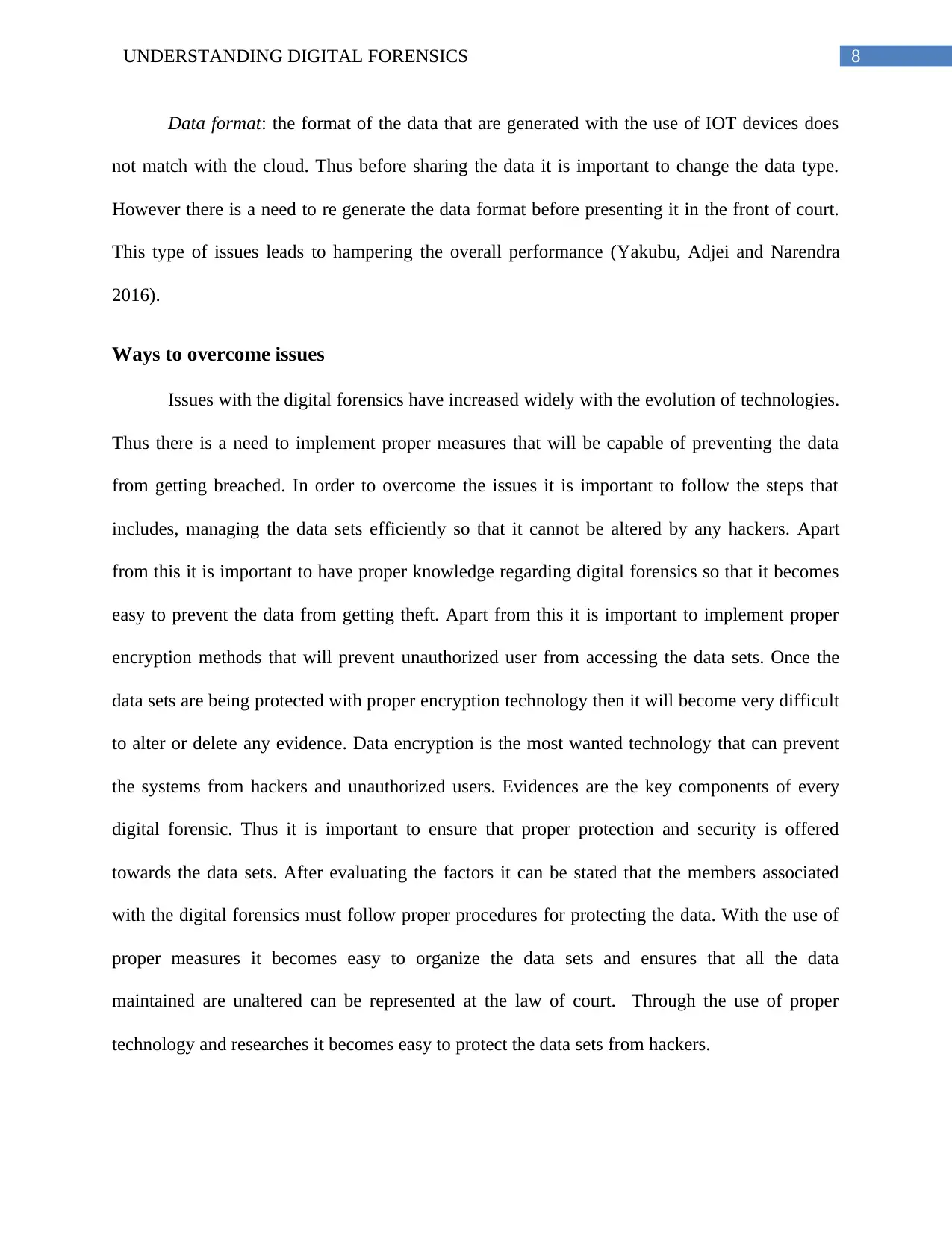
8UNDERSTANDING DIGITAL FORENSICS
Data format: the format of the data that are generated with the use of IOT devices does
not match with the cloud. Thus before sharing the data it is important to change the data type.
However there is a need to re generate the data format before presenting it in the front of court.
This type of issues leads to hampering the overall performance (Yakubu, Adjei and Narendra
2016).
Ways to overcome issues
Issues with the digital forensics have increased widely with the evolution of technologies.
Thus there is a need to implement proper measures that will be capable of preventing the data
from getting breached. In order to overcome the issues it is important to follow the steps that
includes, managing the data sets efficiently so that it cannot be altered by any hackers. Apart
from this it is important to have proper knowledge regarding digital forensics so that it becomes
easy to prevent the data from getting theft. Apart from this it is important to implement proper
encryption methods that will prevent unauthorized user from accessing the data sets. Once the
data sets are being protected with proper encryption technology then it will become very difficult
to alter or delete any evidence. Data encryption is the most wanted technology that can prevent
the systems from hackers and unauthorized users. Evidences are the key components of every
digital forensic. Thus it is important to ensure that proper protection and security is offered
towards the data sets. After evaluating the factors it can be stated that the members associated
with the digital forensics must follow proper procedures for protecting the data. With the use of
proper measures it becomes easy to organize the data sets and ensures that all the data
maintained are unaltered can be represented at the law of court. Through the use of proper
technology and researches it becomes easy to protect the data sets from hackers.
Data format: the format of the data that are generated with the use of IOT devices does
not match with the cloud. Thus before sharing the data it is important to change the data type.
However there is a need to re generate the data format before presenting it in the front of court.
This type of issues leads to hampering the overall performance (Yakubu, Adjei and Narendra
2016).
Ways to overcome issues
Issues with the digital forensics have increased widely with the evolution of technologies.
Thus there is a need to implement proper measures that will be capable of preventing the data
from getting breached. In order to overcome the issues it is important to follow the steps that
includes, managing the data sets efficiently so that it cannot be altered by any hackers. Apart
from this it is important to have proper knowledge regarding digital forensics so that it becomes
easy to prevent the data from getting theft. Apart from this it is important to implement proper
encryption methods that will prevent unauthorized user from accessing the data sets. Once the
data sets are being protected with proper encryption technology then it will become very difficult
to alter or delete any evidence. Data encryption is the most wanted technology that can prevent
the systems from hackers and unauthorized users. Evidences are the key components of every
digital forensic. Thus it is important to ensure that proper protection and security is offered
towards the data sets. After evaluating the factors it can be stated that the members associated
with the digital forensics must follow proper procedures for protecting the data. With the use of
proper measures it becomes easy to organize the data sets and ensures that all the data
maintained are unaltered can be represented at the law of court. Through the use of proper
technology and researches it becomes easy to protect the data sets from hackers.
⊘ This is a preview!⊘
Do you want full access?
Subscribe today to unlock all pages.

Trusted by 1+ million students worldwide
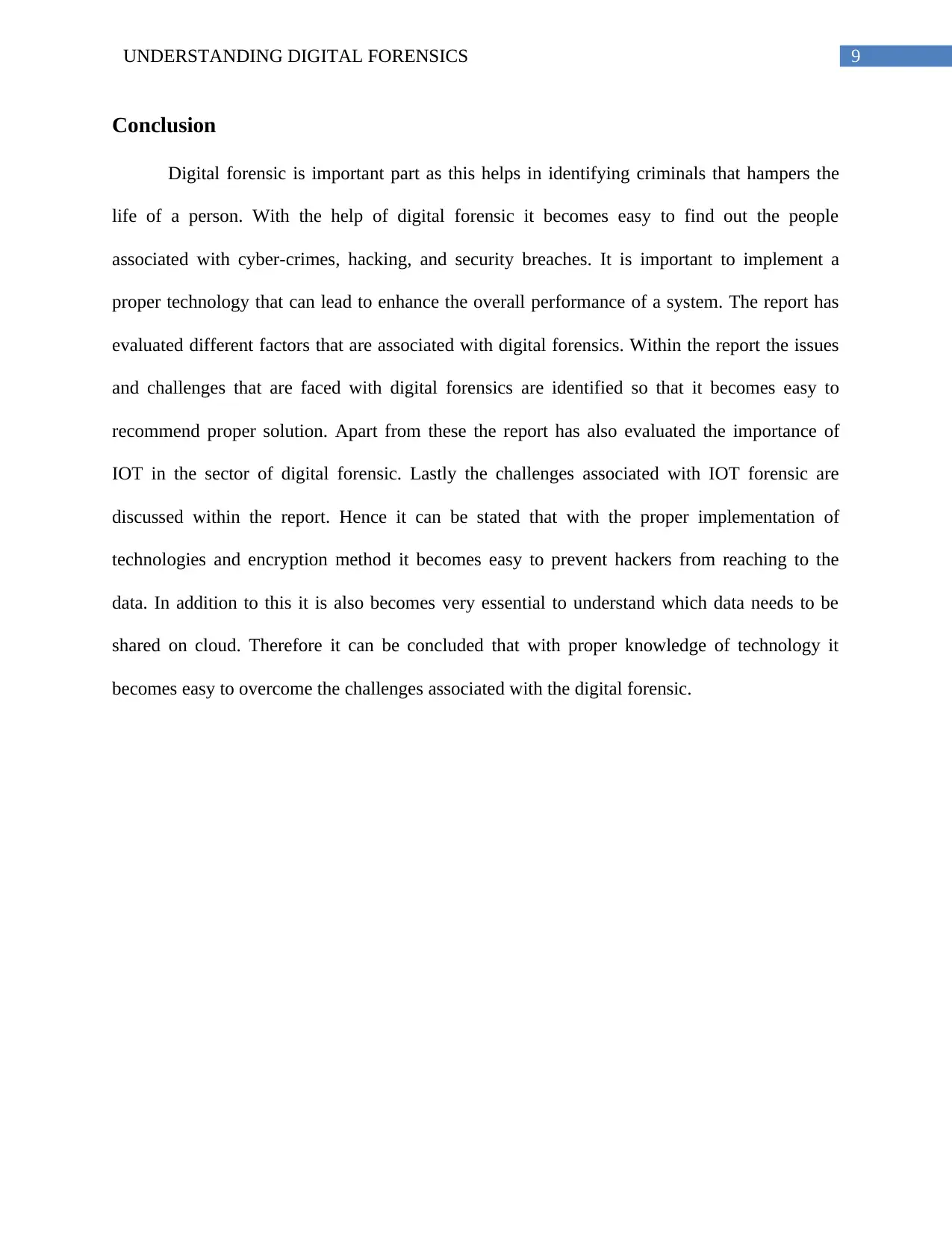
9UNDERSTANDING DIGITAL FORENSICS
Conclusion
Digital forensic is important part as this helps in identifying criminals that hampers the
life of a person. With the help of digital forensic it becomes easy to find out the people
associated with cyber-crimes, hacking, and security breaches. It is important to implement a
proper technology that can lead to enhance the overall performance of a system. The report has
evaluated different factors that are associated with digital forensics. Within the report the issues
and challenges that are faced with digital forensics are identified so that it becomes easy to
recommend proper solution. Apart from these the report has also evaluated the importance of
IOT in the sector of digital forensic. Lastly the challenges associated with IOT forensic are
discussed within the report. Hence it can be stated that with the proper implementation of
technologies and encryption method it becomes easy to prevent hackers from reaching to the
data. In addition to this it is also becomes very essential to understand which data needs to be
shared on cloud. Therefore it can be concluded that with proper knowledge of technology it
becomes easy to overcome the challenges associated with the digital forensic.
Conclusion
Digital forensic is important part as this helps in identifying criminals that hampers the
life of a person. With the help of digital forensic it becomes easy to find out the people
associated with cyber-crimes, hacking, and security breaches. It is important to implement a
proper technology that can lead to enhance the overall performance of a system. The report has
evaluated different factors that are associated with digital forensics. Within the report the issues
and challenges that are faced with digital forensics are identified so that it becomes easy to
recommend proper solution. Apart from these the report has also evaluated the importance of
IOT in the sector of digital forensic. Lastly the challenges associated with IOT forensic are
discussed within the report. Hence it can be stated that with the proper implementation of
technologies and encryption method it becomes easy to prevent hackers from reaching to the
data. In addition to this it is also becomes very essential to understand which data needs to be
shared on cloud. Therefore it can be concluded that with proper knowledge of technology it
becomes easy to overcome the challenges associated with the digital forensic.
Paraphrase This Document
Need a fresh take? Get an instant paraphrase of this document with our AI Paraphraser
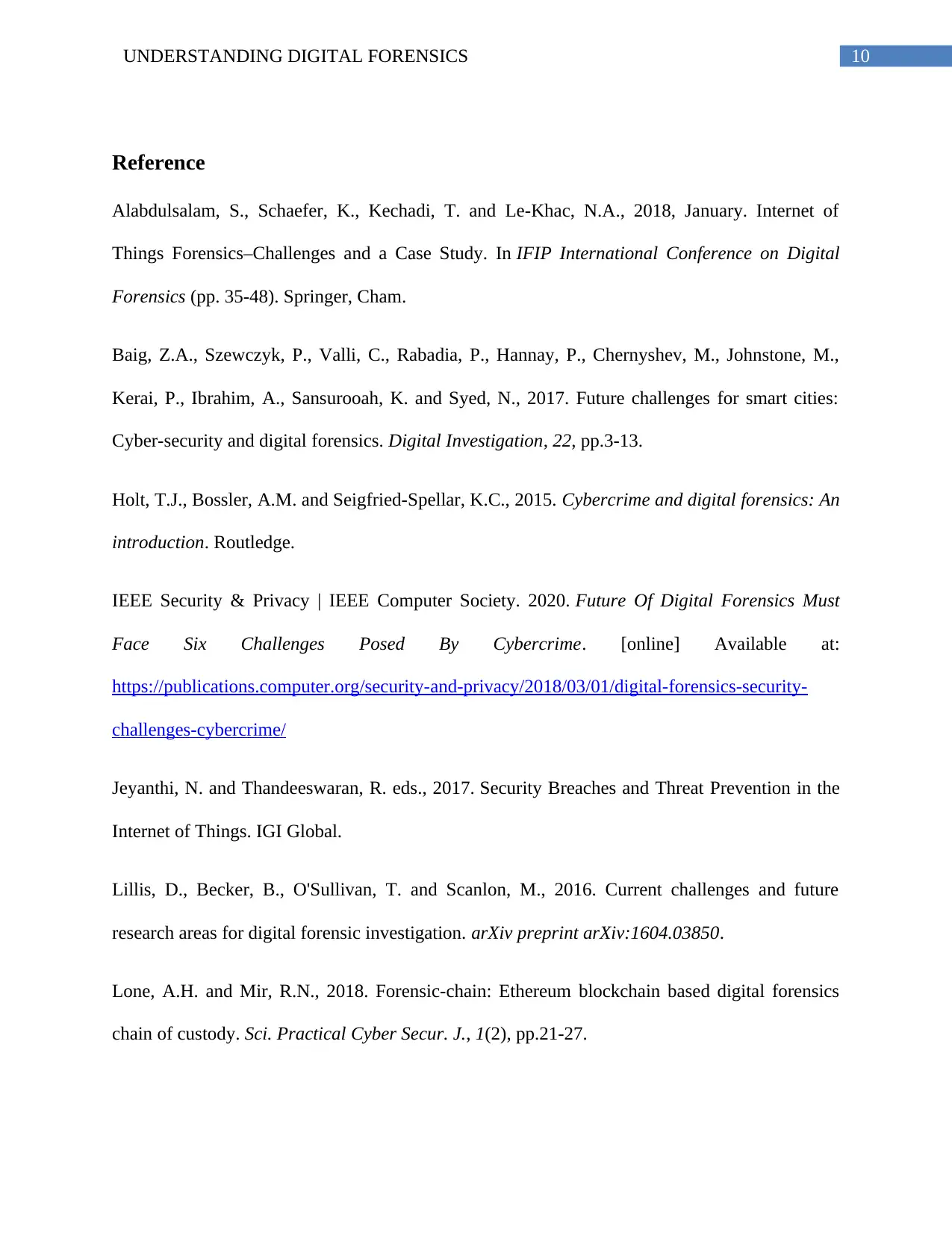
10UNDERSTANDING DIGITAL FORENSICS
Reference
Alabdulsalam, S., Schaefer, K., Kechadi, T. and Le-Khac, N.A., 2018, January. Internet of
Things Forensics–Challenges and a Case Study. In IFIP International Conference on Digital
Forensics (pp. 35-48). Springer, Cham.
Baig, Z.A., Szewczyk, P., Valli, C., Rabadia, P., Hannay, P., Chernyshev, M., Johnstone, M.,
Kerai, P., Ibrahim, A., Sansurooah, K. and Syed, N., 2017. Future challenges for smart cities:
Cyber-security and digital forensics. Digital Investigation, 22, pp.3-13.
Holt, T.J., Bossler, A.M. and Seigfried-Spellar, K.C., 2015. Cybercrime and digital forensics: An
introduction. Routledge.
IEEE Security & Privacy | IEEE Computer Society. 2020. Future Of Digital Forensics Must
Face Six Challenges Posed By Cybercrime. [online] Available at:
https://publications.computer.org/security-and-privacy/2018/03/01/digital-forensics-security-
challenges-cybercrime/
Jeyanthi, N. and Thandeeswaran, R. eds., 2017. Security Breaches and Threat Prevention in the
Internet of Things. IGI Global.
Lillis, D., Becker, B., O'Sullivan, T. and Scanlon, M., 2016. Current challenges and future
research areas for digital forensic investigation. arXiv preprint arXiv:1604.03850.
Lone, A.H. and Mir, R.N., 2018. Forensic-chain: Ethereum blockchain based digital forensics
chain of custody. Sci. Practical Cyber Secur. J., 1(2), pp.21-27.
Reference
Alabdulsalam, S., Schaefer, K., Kechadi, T. and Le-Khac, N.A., 2018, January. Internet of
Things Forensics–Challenges and a Case Study. In IFIP International Conference on Digital
Forensics (pp. 35-48). Springer, Cham.
Baig, Z.A., Szewczyk, P., Valli, C., Rabadia, P., Hannay, P., Chernyshev, M., Johnstone, M.,
Kerai, P., Ibrahim, A., Sansurooah, K. and Syed, N., 2017. Future challenges for smart cities:
Cyber-security and digital forensics. Digital Investigation, 22, pp.3-13.
Holt, T.J., Bossler, A.M. and Seigfried-Spellar, K.C., 2015. Cybercrime and digital forensics: An
introduction. Routledge.
IEEE Security & Privacy | IEEE Computer Society. 2020. Future Of Digital Forensics Must
Face Six Challenges Posed By Cybercrime. [online] Available at:
https://publications.computer.org/security-and-privacy/2018/03/01/digital-forensics-security-
challenges-cybercrime/
Jeyanthi, N. and Thandeeswaran, R. eds., 2017. Security Breaches and Threat Prevention in the
Internet of Things. IGI Global.
Lillis, D., Becker, B., O'Sullivan, T. and Scanlon, M., 2016. Current challenges and future
research areas for digital forensic investigation. arXiv preprint arXiv:1604.03850.
Lone, A.H. and Mir, R.N., 2018. Forensic-chain: Ethereum blockchain based digital forensics
chain of custody. Sci. Practical Cyber Secur. J., 1(2), pp.21-27.
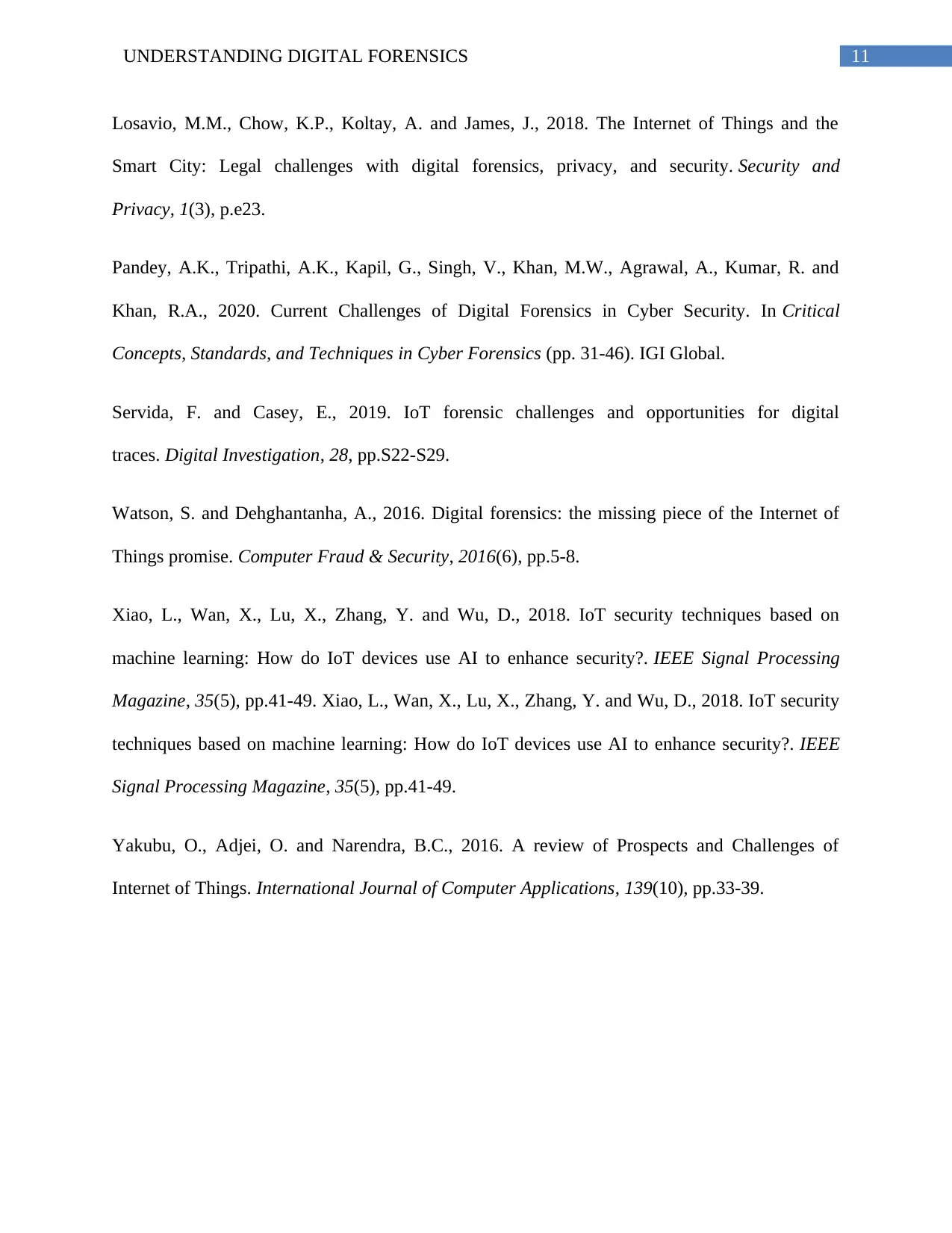
11UNDERSTANDING DIGITAL FORENSICS
Losavio, M.M., Chow, K.P., Koltay, A. and James, J., 2018. The Internet of Things and the
Smart City: Legal challenges with digital forensics, privacy, and security. Security and
Privacy, 1(3), p.e23.
Pandey, A.K., Tripathi, A.K., Kapil, G., Singh, V., Khan, M.W., Agrawal, A., Kumar, R. and
Khan, R.A., 2020. Current Challenges of Digital Forensics in Cyber Security. In Critical
Concepts, Standards, and Techniques in Cyber Forensics (pp. 31-46). IGI Global.
Servida, F. and Casey, E., 2019. IoT forensic challenges and opportunities for digital
traces. Digital Investigation, 28, pp.S22-S29.
Watson, S. and Dehghantanha, A., 2016. Digital forensics: the missing piece of the Internet of
Things promise. Computer Fraud & Security, 2016(6), pp.5-8.
Xiao, L., Wan, X., Lu, X., Zhang, Y. and Wu, D., 2018. IoT security techniques based on
machine learning: How do IoT devices use AI to enhance security?. IEEE Signal Processing
Magazine, 35(5), pp.41-49. Xiao, L., Wan, X., Lu, X., Zhang, Y. and Wu, D., 2018. IoT security
techniques based on machine learning: How do IoT devices use AI to enhance security?. IEEE
Signal Processing Magazine, 35(5), pp.41-49.
Yakubu, O., Adjei, O. and Narendra, B.C., 2016. A review of Prospects and Challenges of
Internet of Things. International Journal of Computer Applications, 139(10), pp.33-39.
Losavio, M.M., Chow, K.P., Koltay, A. and James, J., 2018. The Internet of Things and the
Smart City: Legal challenges with digital forensics, privacy, and security. Security and
Privacy, 1(3), p.e23.
Pandey, A.K., Tripathi, A.K., Kapil, G., Singh, V., Khan, M.W., Agrawal, A., Kumar, R. and
Khan, R.A., 2020. Current Challenges of Digital Forensics in Cyber Security. In Critical
Concepts, Standards, and Techniques in Cyber Forensics (pp. 31-46). IGI Global.
Servida, F. and Casey, E., 2019. IoT forensic challenges and opportunities for digital
traces. Digital Investigation, 28, pp.S22-S29.
Watson, S. and Dehghantanha, A., 2016. Digital forensics: the missing piece of the Internet of
Things promise. Computer Fraud & Security, 2016(6), pp.5-8.
Xiao, L., Wan, X., Lu, X., Zhang, Y. and Wu, D., 2018. IoT security techniques based on
machine learning: How do IoT devices use AI to enhance security?. IEEE Signal Processing
Magazine, 35(5), pp.41-49. Xiao, L., Wan, X., Lu, X., Zhang, Y. and Wu, D., 2018. IoT security
techniques based on machine learning: How do IoT devices use AI to enhance security?. IEEE
Signal Processing Magazine, 35(5), pp.41-49.
Yakubu, O., Adjei, O. and Narendra, B.C., 2016. A review of Prospects and Challenges of
Internet of Things. International Journal of Computer Applications, 139(10), pp.33-39.
⊘ This is a preview!⊘
Do you want full access?
Subscribe today to unlock all pages.

Trusted by 1+ million students worldwide
1 out of 12
Related Documents
Your All-in-One AI-Powered Toolkit for Academic Success.
+13062052269
info@desklib.com
Available 24*7 on WhatsApp / Email
![[object Object]](/_next/static/media/star-bottom.7253800d.svg)
Unlock your academic potential
Copyright © 2020–2025 A2Z Services. All Rights Reserved. Developed and managed by ZUCOL.





